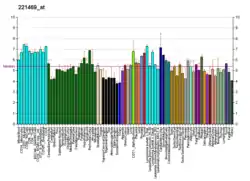| GPR32 | |||||||||||||||||||||||||||||||||||||||||||||||||||
|---|---|---|---|---|---|---|---|---|---|---|---|---|---|---|---|---|---|---|---|---|---|---|---|---|---|---|---|---|---|---|---|---|---|---|---|---|---|---|---|---|---|---|---|---|---|---|---|---|---|---|---|
| Identifiers | |||||||||||||||||||||||||||||||||||||||||||||||||||
| Aliases | GPR32, RVDR1, G protein-coupled receptor 32 | ||||||||||||||||||||||||||||||||||||||||||||||||||
| External IDs | OMIM: 603195 HomoloGene: 88647 GeneCards: GPR32 | ||||||||||||||||||||||||||||||||||||||||||||||||||
| |||||||||||||||||||||||||||||||||||||||||||||||||||
| |||||||||||||||||||||||||||||||||||||||||||||||||||
| |||||||||||||||||||||||||||||||||||||||||||||||||||
| Wikidata | |||||||||||||||||||||||||||||||||||||||||||||||||||
| |||||||||||||||||||||||||||||||||||||||||||||||||||
G protein-coupled receptor 32, also known as GPR32 or the RvD1 receptor, is a human receptor (biochemistry) belonging to the rhodopsin-like subfamily of G protein-coupled receptors.[3]
Gene
The GPR32 was initially identified and defined by molecular cloning in 1998 as coding for an orphan receptor, i.e. a protein with an amino acid sequence similar to known receptors but having no known ligand(s) to which it responds and no known function. The projected amino acid sequence of GPR32, however, shared 35-39% amino acid identity with certain members of the chemotactic factor receptor family, i.e. 39% identity with Formyl peptide receptor 1, which is a receptor for N-Formylmethionine-leucyl-phenylalanine and related N-formyl peptide chemotactic factors, and 35% identity with Formyl peptide receptor 2, which likewise is also a receptor for N-formyl peptides but also a receptor for certain lipoxins which are arachidonic acid metabolites belonging to a set of specialized proresolving mediators that act to resolve or inhibit inflammatory reactions. GPR32 mapped to chromosomal 19, region q13.3.[4] There are no mouse or other orthologs of GPR32.[5]
Receptor
The GPR32 protein is a G protein coupled receptor although the specific G protein subtypes which it activates has not yet been reported. GPR32 is expressed in human blood neutrophils, certain types of blood lymphocytes (i.e. activated CD8+ cells, CD4+ T cells, and T helper 17 cells), tissue macrophages, small airway epithelial cells, and adipose tissue.[5][6][7] When expressed in Chinese hamster ovary cells, GPR32 inhibits the Cyclic adenosine monophosphate signaling pathway under both baseline and forskolin-stimulated conditions indicating that it is a member of the class of orphan G protein coupled receptors that possesses constitutive signaling activity.[8]
At least 6 members of the D series of resolvins (RvDs) viz., RvD1, RvD2m AT-RVD1, RvD3, AT-RvD3, and RvD5, activate their target cells through this receptor; these results have led to naming GPR32 the RVD1 receptor (see resolvin mechanisms of action).[9][10][11] RvDs are members of the specialized proresolving mediators (SPM) class of polyunsaturated fatty acid metabolites. RVDs are metabolites of the omega-3 fatty acid, docosahexaenoic acid (DHA), and, along with other SRMs contribute to the inhibition and resolution of a diverse range of inflammation and inflammation-related responses as well as to the healing of these inflammatory lesions in animals and humans.[12] The metabolism of DHA to RVD's and the activation of GPR32 by these RVD's are proposed to be one mechanism by which omega-3 fatty acids may ameliorate inflammation as well as various inflammation-based and other diseases.[13]
References
- 1 2 3 GRCh38: Ensembl release 89: ENSG00000142511 - Ensembl, May 2017
- ↑ "Human PubMed Reference:". National Center for Biotechnology Information, U.S. National Library of Medicine.
- ↑ "Entrez Gene: GPR32 G protein-coupled receptor 32".
- ↑ Marchese A, Nguyen T, Malik P, Xu S, Cheng R, Xie Z, Heng HH, George SR, Kolakowski LF, O'Dowd BF (June 1998). "Cloning genes encoding receptors related to chemoattractant receptors". Genomics. 50 (2): 281–6. doi:10.1006/geno.1998.5297. PMID 9653656.
- 1 2 Schmid M, Gemperle C, Rimann N, Hersberger M (2016). "Resolvin D1 Polarizes Primary Human Macrophages toward a Proresolution Phenotype through GPR32". Journal of Immunology. 196 (8): 3429–37. doi:10.4049/jimmunol.1501701. PMID 26969756.
- ↑ Norling LV, Dalli J, Flower RJ, Serhan CN, Perretti M (2012). "Resolvin D1 limits polymorphonuclear leukocyte recruitment to inflammatory loci: receptor-dependent actions". Arteriosclerosis, Thrombosis, and Vascular Biology. 32 (8): 1970–8. doi:10.1161/ATVBAHA.112.249508. PMC 3401489. PMID 22499990.
- ↑ Hsiao HM, Thatcher TH, Levy EP, Fulton RA, Owens KM, Phipps RP, Sime PJ (2014). "Resolvin D1 attenuates polyinosinic-polycytidylic acid-induced inflammatory signaling in human airway epithelial cells via TAK1". Journal of Immunology. 193 (10): 4980–7. doi:10.4049/jimmunol.1400313. PMC 4409010. PMID 25320283.
- ↑ Orr SK, Colas RA, Dalli J, Chiang N, Serhan CN (2015). "Proresolving actions of a new resolvin D1 analog mimetic qualifies as an immunoresolvent". American Journal of Physiology. Lung Cellular and Molecular Physiology. 308 (9): L904–11. doi:10.1152/ajplung.00370.2014. PMC 4421783. PMID 25770181.
- ↑ Krishnamoorthy S, Recchiuti A, Chiang N, Yacoubian S, Lee CH, Yang R, Petasis NA, Serhan CN (January 2010). "Resolvin D1 binds human phagocytes with evidence for proresolving receptors". Proceedings of the National Academy of Sciences of the United States of America. 107 (4): 1660–5. Bibcode:2010PNAS..107.1660K. doi:10.1073/pnas.0907342107. PMC 2824371. PMID 20080636.
- ↑ Serhan CN, Chiang N, Dalli J, Levy BD (February 2015). "Lipid mediators in the resolution of inflammation". Cold Spring Harbor Perspectives in Biology. 7 (2): a016311. doi:10.1101/cshperspect.a016311. PMC 4315926. PMID 25359497.
- ↑ Orr SK, Colas RA, Dalli J, Chiang N, Serhan CN (May 2015). "Proresolving actions of a new resolvin D1 analog mimetic qualifies as an immunoresolvent". American Journal of Physiology. Lung Cellular and Molecular Physiology. 308 (9): L904-11. doi:10.1152/ajplung.00370.2014. PMC 4421783. PMID 25770181.
- ↑ Headland SE, Norling LV (May 2015). "The resolution of inflammation: Principles and challenges". Seminars in Immunology. 27 (3): 149–60. doi:10.1016/j.smim.2015.03.014. PMID 25911383.
- ↑ Calder PC (April 2015). "Marine omega-3 fatty acids and inflammatory processes: Effects, mechanisms and clinical relevance". Biochimica et Biophysica Acta (BBA) - Molecular and Cell Biology of Lipids. 1851 (4): 469–84. doi:10.1016/j.bbalip.2014.08.010. PMID 25149823.
Further reading
- Marchese A, Nguyen T, Malik P, Xu S, Cheng R, Xie Z, Heng HH, George SR, Kolakowski LF, O'Dowd BF (June 1998). "Cloning genes encoding receptors related to chemoattractant receptors". Genomics. 50 (2): 281–6. doi:10.1006/geno.1998.5297. PMID 9653656.


